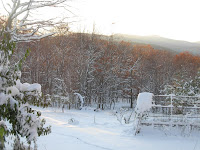
 Two views from autumnal Lake Placid:left picture is a maple down an alley off Main Streetright picture is Whiteface Mountain from the Golden Arrow Lakeside Resort
Two views from autumnal Lake Placid:left picture is a maple down an alley off Main Streetright picture is Whiteface Mountain from the Golden Arrow Lakeside ResortIf you need a short get away in a scenic, low stress spot near the East Coast, put a fall visit to the village Lake Placid at the top of your list.
2011 is an excellent year for fall foliage, so the trip to Lake Placid should be delightful whether you are coming from the north, south, east or west. Sometimes, the leaves are set off by early season snow, so keep an eye on the weather before you go.
Tropical Storms Irene and Lee inflicted much damage to the Adirondacks. Route 73, the main access to Lake Placid, was badly damaged. Large portions were washed away by flood waters. State and local governments have restored many highways. For example, according to Carol Breen, a spokesperson for the New York State Department of Transportation, the agency’s emergency contractor and maintenance staff worked tirelessly and reopened Route 73 to traffic in just two weeks - - an effort that was one of Governor Cuomo's top priorities after the storms. Breen advises that other State highways in the region are largely reopened with some other work spots remaining: alternating one-way traffic on Route 9 through Elizabethtown in Essex County, work to repair shoulders or guiderail and work to restore streams and protect highways in the future.
Lake Placid and the surrounding communities have so many things to do that it’s possible to plan an enjoyable visit that is an overnight - - or longer. There are many hotels and motels in the village of Lake Placid which, for God knows what reason, is actually on Mirror Lake. If you find a place to stay in the village, you can park your car and shop and dine on foot. Of course, you can get back in the car and go to visit the venues from the 1980 Olympics, Whiteface Mountain, the Ausable River or one of many hiking trails.
In this post, activities mentioned were discovered on several recent trips that our family has taken to the region. If want more ideas, contact the Lake Placid Convention and Visitors Bureau at 518-523-2445 or visit their website,
http://www.lakeplacid.com/.
The Lake Placid Convention Center is a dominant landmark in the Village. It was the site of the US Hockey Team’s upset victory sweep in the 1980 Olympics and overlooks the speed skating rink used in the 1932 and 1980 Olympics. Even if the Convention Center has no events scheduled, it’s worth walking up to its entrance. From this spot is an exquisite view back to the south and east of the High Peaks.
For lodging, one of my favorite places is the
Golden Arrow Lakeside Resort, tucked between Main Street and Mirror Lake. Many of the rooms at the Golden Arrow overlook the Lake and the hotel is very close to shops and restaurants. The Golden Arrow has also taken great strides to make itself environmentally sustainable and has received awards for this effort. However, the excellent service by the staff and the well-appointed rooms show that being good to the environment does not require privation.
Because this month is an interlude between summer and winter activities, it is possible to find great sales in some stores. As you walk along Main Street, merchants are not shy about advertising deals.
If you need fishing tackle or hiking gear,
Jones Outfitters has an excellent selection. When we visited the store last year, the staff was also great at helping us make an informed choice. Jones will also share local fishing conditions.
A few minutes from Lake Placid is the Ausable River. On a fall trip to the region some years ago, I hooked a trout on my first cast in an upper stretch of the stream. A reasonable distance away is the Bouqet River, which has a fall run of landlocked salmon below Wadhams in eastern Essex County and good trout fishing throughout.
Terry Robards, the former wine columnist for The New York Times has an appealing
wine and liquor store on Main Street. His website states, “A naturally cool cellar beneath the store holds the largest wine inventory in the North Country.”
At mid-point on Main Street is a row of outlets: Van Heusen, Izod and Bass. If you are running low on work clothes or need to get a jump on holiday shopping, this is a great place to stop.
For meals, the Golden Arrow offers a good assortment of breakfast items. Their restaurant also serves other meals but we did not have a chance to try them.
We enjoyed the Cottage, the
Mirror Lake Inn’s pub/bistro that is right on Mirror Lake. The Cottage’s name belies its generous-sized interior. With the size of the room, the fireplace and the popularity on the weekend, the Cottage is bustling and lively without making bar patrons or diners feeling crammed in.
The next day we found Soulshine, a nice bagel place on Main Street and for lunch enjoyed a bagel and a cup of soup to ward off the cooler weather that had moved in overnight.
We left Lake Placid on a sunny day with the leaves at their peak, refreshed after a tiring week. We can’t wait to come back - - regardless of the season.



































